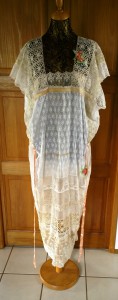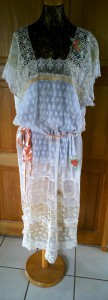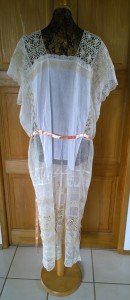Actually I should call it my “obstacle-gown”.
From the start, there where some problems. The vintages original (a bridal gown ) included some of the finest, hand-embroidered batiste. Thanks to the californian-treasures, I had a matching piece in the same style and good condition. But it was to broad. To make it fit, I had to to cut it up and remove some of the embroidery on the edge, which I didn´t want to. That ment, I had to find another one. But all I had, was a hand-embroidered piece in a complete different style. It´s pretty too, but matches not half as good, als the other one did. And it was also to broad But I didn´t want to cut it up either.
So I had to add on another row of lace on the neckline, to prevent the gown from slipping down the shoulders.
The neckline of the genuine gown was very high too. I found that not comfortable and decided to give my version more space. I also couldn´t copy the flouncy sideparts, because non of my vintage lace had the right lenght. So I had to adjust the pattern to the existing material.
After that, I found some unexpected little flaws on the net lace, that had to be mend. And than I had to add on some rather rough bobbin-lace, because I hadn´t enough left of the finer ones.
That gives my gown very little resemblance to the original, but I don´t mind. It makes the whole thing more individual.
Certainly, I wear it with some under-gowns in different colors.
At the end I decided to add on a waist-ribbon, because the gown looked much better with a little gathering.
The rose-decoration is handmade from vintage ribbons and the tiny blue flowers handembroidered from old sild thread.
“But”, you would object. “This looks like a night gown!”
That´s right. But the reason ist simple: Till the end of the 1020s, they made no difference in the use of material between girls clothing, womens lingerie, summer dresses and sometimes evening wear. For the whole range, the same lace and fabrics like silk, satin, fine linen or batiste have been wildly mixed. Even the sewing-patterns where nearly the same.
The works of the Callot- und Bouét soeurs are the best examples. They even used the same embellishments for both, gowns and lingerie. So beholders of today can hardly see the difference.




